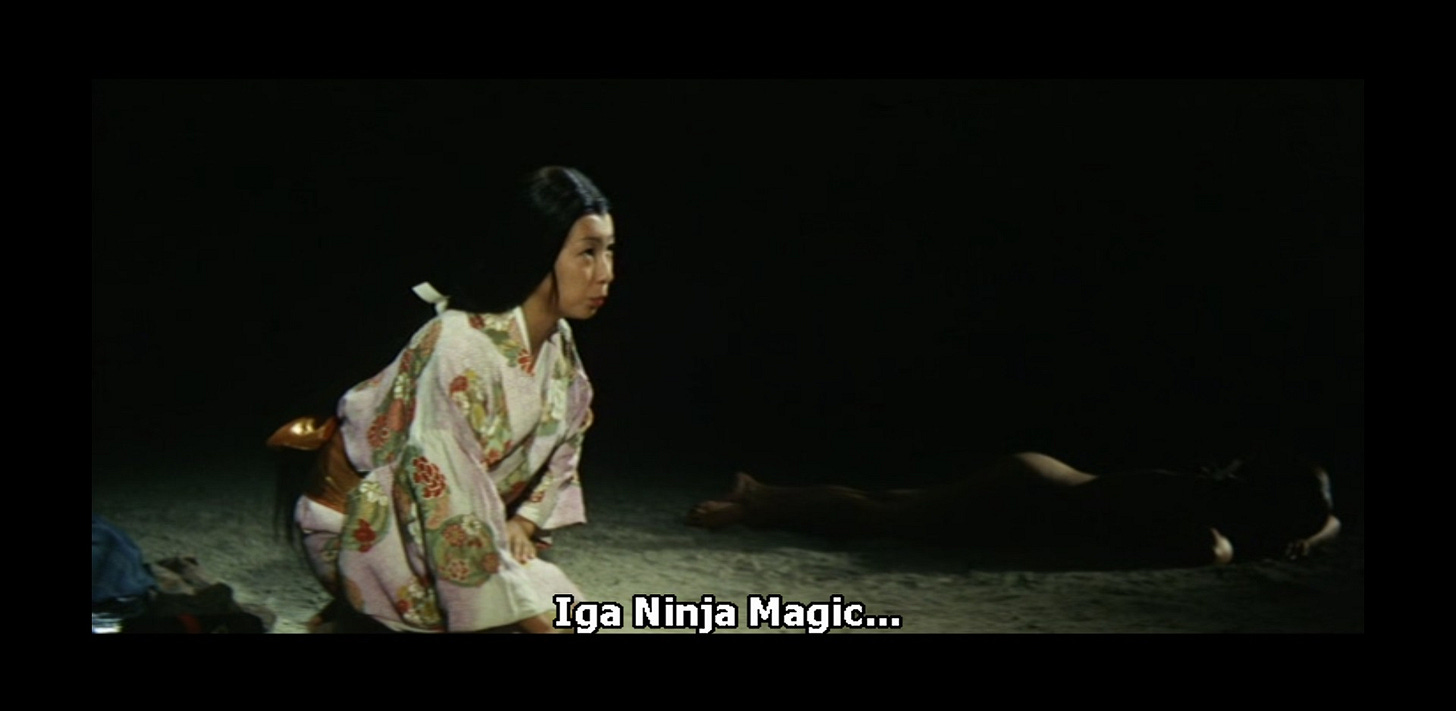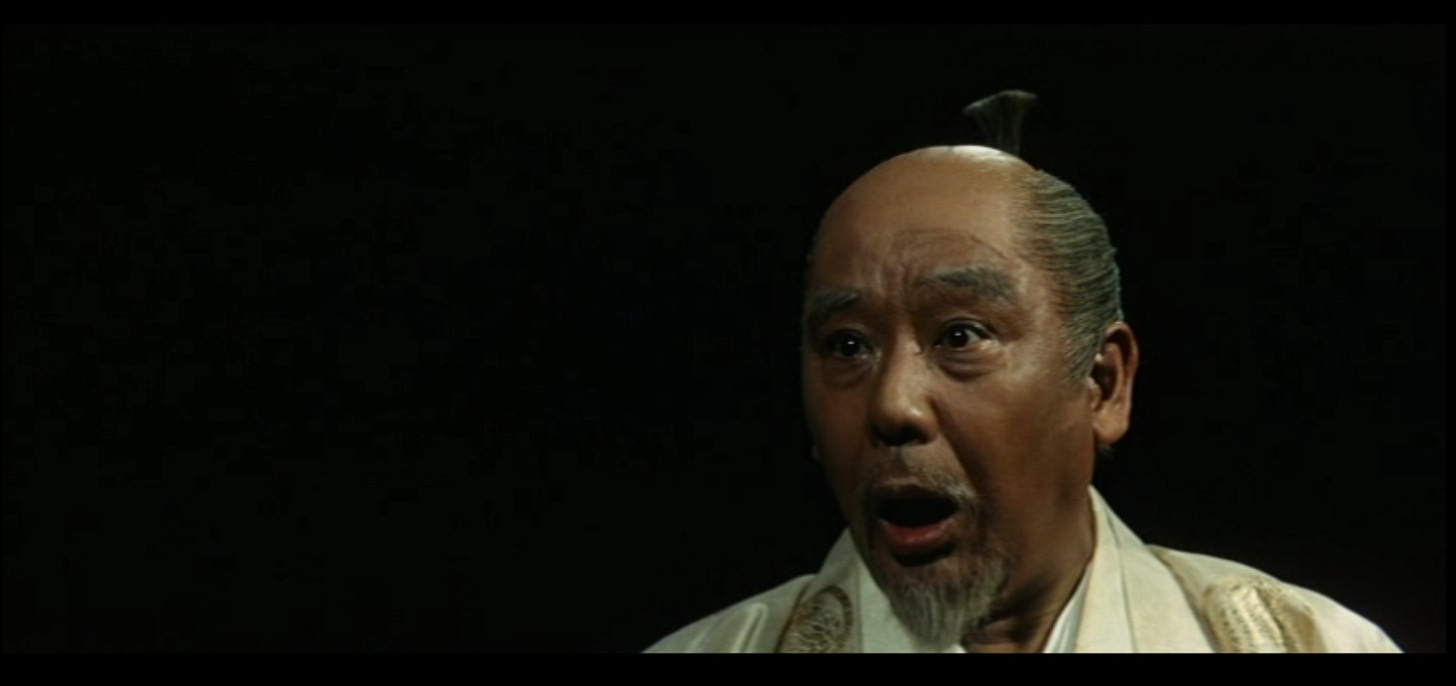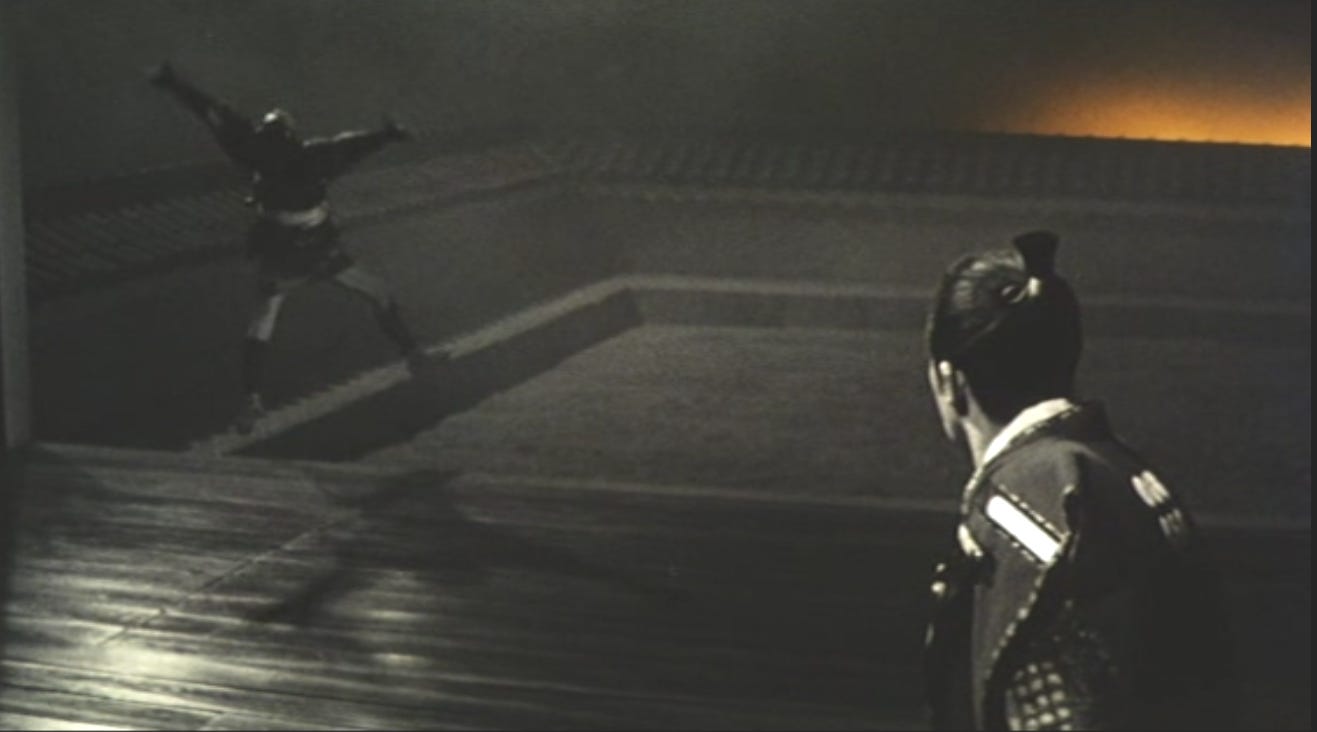Just Your Typical Ninja Sex Comedy
Yamada Fūtarō's 1964 film "Ninja Lady Magic" (Kunoichi Ninpō)

I’ve written a fair few posts here at Critical Ninja Theory about the kunoichi, the supposed seductress-assassins trained and used by medieval Japanese ‘ninja’ clans. The TL:DR is that they didn’t exist; there’s a couple of lines in one 1676 military manual about maybe using women in infiltration operations, but no evidence that anyone ever actually did this. The kunoichi is almost entirely a modern media creation, popularized through novels and films from the early 1960s and then absorbed into the big sticky ball of supposedly historical ‘ninja’ lore by the usual suspects.
In his 2017 study of the topic, Japanese scholar Yoshimaru Katsuya has suggested that the word kunoichi wasn’t automatically read as meaning “female ninja” until the mid-1960s; before then, it appears to have been an obscure slang term denoting women in general. Yoshimaru think that the ‘ninja’ connection for the word may have been cemented in the public consciousness by the film we’re about to discuss, Nakajima Sadao’s Kunoichi ninpō (‘Ninja Lady Magic’) from 1964.1 The word kunoichi isn’t used in the film itself to refer to female ninja - they’re simply onna ninja, or women ninja - but it’s likely that people seeing the film’s title or its promotional posters came away thinking that was what kunoichi meant.2
Anyway, I’ve watched the film - which you may recall I described a few months ago as “batshit insane” - mostly so you don’t have to.
These Guys are Magic with the Ladies
As it’s used in the context of Ninja Lady Magic, then, the term kunoichi in fact refers to male ninja using magical powers to assume the form of a woman. This is made clear right at the start, when a group of five male Iga ninja are summoned to present themself before Tokugawa Ieyasu, by this point more or less the supreme ruler of Japan.3 The ninja come across initially as a bunch of country bumpkins, until one of them - not exactly a looker if we’re being honest:
…demonstrates his powers by spitting a needle at one of Ieyasu’s ladies-in-waiting. This woman is then seized by uncontrollable lust for the ninja, and once nature has taken its inevitable course, the ninja is able to assume the woman’s form. We can tell because the woman speaks in the ninja’s voice for a moment or two, telling us that this is:
Specifically, it’s the kunoichi-geshō spell, meaning literally “woman’s make-up.”4
Tokugawa Ieyasu, as you’d expect, is quite impressed:
…and hires the ninja for the job.
What job, I hear you ask?
The Last Bit of Historical Fact You’ll Get Today
Here we need to consider what passes for the historical background to Ninja Lady Magic. The film is set mostly after the fall of Osaka Castle to the Tokugawa and the death of Toyotomi Hideyori in 1615, but unless you’re well-versed in late medieval Japanese history, we should back up a bit and explain what’s going on.5
In 1598, the warlord Toyotomi Hideyoshi passed away from illness. He was the second of the great unifiers of Japan, after Oda Nobunaga and before Tokugawa Ieyasu, and by some distance the most powerful person in the country at the time of his death. He had, however, had considerable difficulty in siring a direct biological heir to take over from him; his son and heir in 1598, Toyotomi Hideyori, had only been born in 1593 and so was not old enough to take over the running of the country. Fully aware of this, Hideyoshi convened a council of his five most powerful vassals shortly before he died, then made them swear to protect Hideyori and run the country in his stead until Hideyori was old enough to govern himself.
Given the degree of loyalty of your average Warring States samurai, you can imagine how well that worked out. Rivalries among these five warlords emerged almost immediately, and within two years of Hideyoshi’s death one of the five, Tokugawa Ieyasu, had succeeded in crushing all of his other rivals with a remarkably one-sided victory at the Battle of Sekigahara in the ninth month of 1600. That was more or less the moment that the Warring States period ended and the Tokugawa Shogunate began, lasting for more than 250 years to 1867.
Toyotomi Hideyori, in the meantime, was still around and grew to some semblance of maturity over the next fourteen years or so (1600-1614). Hideyori’s continued presence at Osaka Castle, one of his father’s main residences, was a problem for Ieyasu, since he had technically sworn to protect him, as had a fair number of other major warriors. Things got complicated - let’s put it that way - and by 1614, they’d devolved into outright hostilities. Ieyasu would lay siege to Osaka Castle twice, in the autumn/winter of 1614 and again in the summer of 1615, with an uneasy truce in between. The Toyotomi forces fought fairly well in the first campaign, in no small part to the efforts of the legendary warrior Sanada Yukimura, but they couldn’t hold out for ever against more or less the whole of the rest of the country.6
When the Tokugawa came against Osaka for the second time in the summer of 1615, the result was the destruction of the castle and Hideyori’s death by suicide, thus bringing an end to the Toyotomi bloodline and removing the last obstacles to Tokugawa power. One complicating factor was that Ieyasu’s grand-daughter Lady Sen (Senhime) had married Hideyori some years earlier as a way of strengthening ties between the Tokugawa and Toyotomi.7 She was, in the event, rescued from the castle before it was completely destroyed, and would later remarry into the family of one of Ieyasu’s top generals.
A Womb With a View
The beginning of Ninja Lady Magic puts us around a day before the fall of Osaka Castle in 1615. As flames roar around the castle, the defending commander Sanada Yukimura hatches a plan for the survival of the Toyotomi. Five of Sanada’s female ninja must have sex with Hideyori so as to carry on his “seed” and ensure the Toyotomi line will live on, even if Hideyori himself dies:
So the plan is hatched, and the female ninja head off to do their duty. Very shortly after this one of Sanada’s male ninja named Sasuke - presumably the famous Sarutobi Sasuke - shows up to speak with him. A few moments later Sasuke detects an intruder and tries to go after him, only to be shot and killed in ludicrously dramatic fashion:
Yukimura himself is picked off moments later, and thus perish the two heroes. However, their role in the film is far from done, because their spirits, after stopping to chat for a moment, decide they’re not going to head off to the next life just yet. Instead, they’ll stick around for a bit to see what happens:
This results in a weird (and occasionally hilarious) setup whereby Sasuke and his lord Yukimura are occasionally revealed to be watching and commenting on the action, kind of like a ninja version of Mystery Science Theater 3000. Since a lot of the film involves sex in some way, this inevitably puts Sasuke and Yukimura in the position of basically voyeurs. They, and the film itself, are far from unaware of this; in one particularly funny scene mid-way through, Sasuke prudently elects to drop the wooden shutters on an, uh, ‘encounter’ between one of the Iga ninja and one of Sanada’s female ninja. This discretion does not go down well with his boss, who was apparently looking forward to the whole thing:
Anyway, Lady Sen is rescued from Osaka Castle by the Tokugawa forces, as happened in real life, and returns to Ieyasu’s castle at Sunpu. Thinking that he’s now got everything sewn up, Ieyasu is shocked to learn that (a) Lady Sen herself is already pregnant with Hideyori’s child; (b) she intends to keep it and remain loyal to her husband, even to the point of avenging his death; and (c) the late Sanada Yukimura’s five female ninja are among the ladies-in-waiting Sen has brought back with her.
This, then, is the job for which Ieyasu needs the Iga ninja we saw earlier. He needs to make sure the Toyotomi are gone for good, so he’s got to figure out a way to kill Hideyori’s unborn son without harming his daughter. Or at least without his daughter knowing what he’s done. Lovely fella, that Ieyasu.
So this is our setup after the first fifteen or so minutes of the film: Ieyasu is out to kill Lady Sen’s child using the male Iga ninja, while Lady Sen has to try to survive, protected by the five female ninja concealed among her ladies-in-waiting.
We’ll get to the main action in the next post, since we’re running out of room here. Trust me when I say that hilarity will ensue.
Nakajima Sadao 中島貞夫 (1934-2023); Yoshimaru Katsuya, “Kunoichi to wa nani ka” [What is a Kunoichi?] in Yoshimaru, Yamada Yūji, eds., Ninja no tanjō (Bensei Shuppan, 2017), p. 185-6.
Onna ninja 女忍者.
Tokugawa Ieyasu 徳川家康 (1543-1616).
Kunoichi-geshō くノ一化粧.
Toyotomi Hideyori 豊臣秀頼 (1593-1615).
Sanada Yukimura 真田幸村 (1567-1615).
Senhime 千姫 (1597-1666). In reality Lady Sen was Ieyasu’s grand-daughter rather than his daughter, but honestly, given all of the other wacky stuff in the film…












Are you considering taking on Yamada Fūtarō's 1959 Kōka ninpōchō 甲賀忍法帖? There is some weird female ninja *jutsu* in there as well :-) (I wonder if that is the book that created the Iga vs. Koga rivalry image)